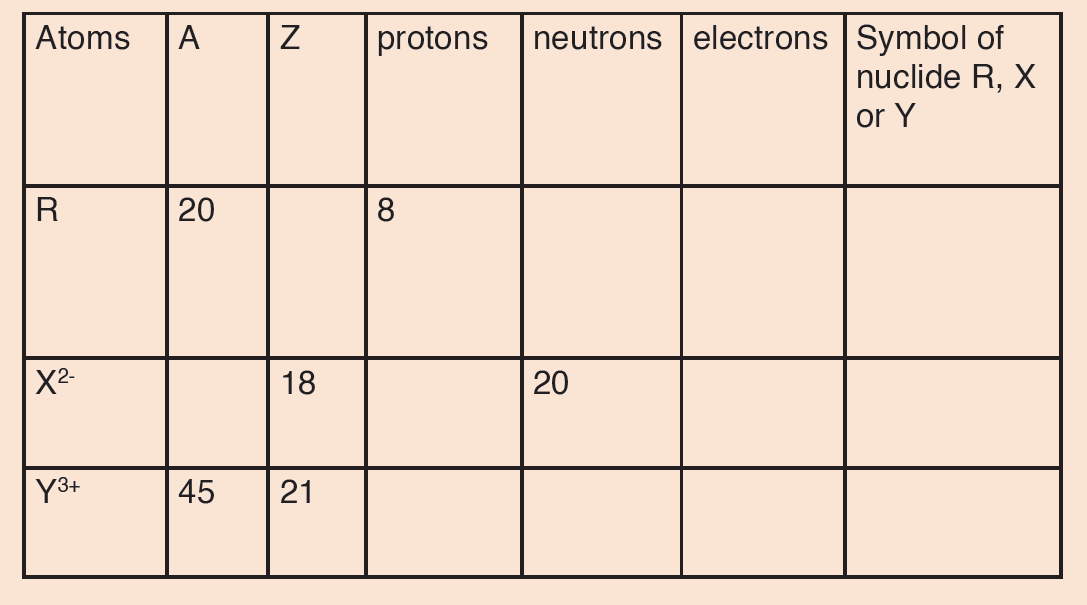UNIT 3: STRUCTURE OF AN ATOM
Calculate relative atomic mass (R.A.M) of different elements.
Introductory Activity
The illustrations A, B, and C below show three atomic nuclei of different elements. Study the illustrations carefully and answer the questions below.
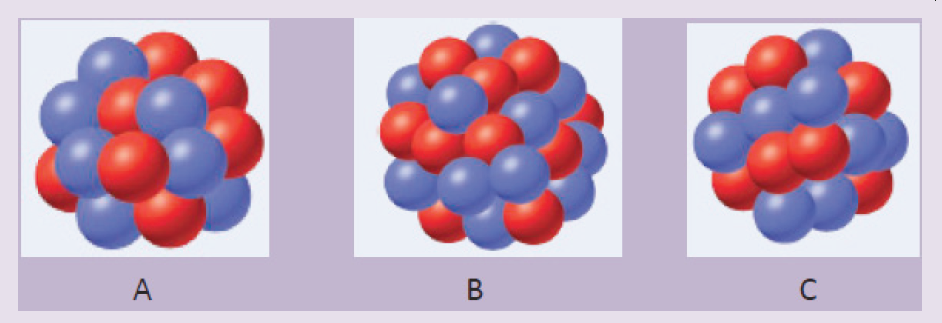
1. How many blue and red spheres do you see in each of the diagrams above?
2. What do the three diagrams A, B, and C have in common?
3. Based on your knowledge concerning atomic structure, what do you think that
a) the blue spheres represent?
b) the red spheres represent? Provide explanations.
4. Are there some other particle(s) missing from the above diagrams?
If yes name the particle(s).
5. What could you obtain if the atom is broken down?
Each country has its own culture (language, traditions and norms, attitudes
and values, etc.). Our culture defines our identity which is unique to each
Rwandan citizen and differentiates us from foreigners; if one element of our
culture is rejected or disappears, we become a different Rwandan people.
When we introduce foreign cultures to replace ours, we can lose our identity.
However, some of our cultural elements such as language can be shared
with others to build the social relationship.
Similarly, in the atom, the number of protons within the nucleus defines
the atomic number, which is unique to each chemical element; the atomic
number or the number of protons of an atom defines its identity. If a proton
is added or removed from an element, it becomes a different element.
Electrons around the nucleus can be lost, gained, or shared to create bonds
with other atoms in chemical reactions to produce useful substance, but this
does not change the identity of the elements involved.
3.1. The constituents of an atom, their properties and the outline of their discovery
Activity 3.1
1. Chemists study the structures, physical properties and chemical
properties of material substances. These consist of matter.
a) What is matter?
b) From the list that follows, show what is matter and what is not
matter: gold, energy peanuts, light, smoke, ideas, sounds. Provide explanations
2. List the components of matter and describe each component.
3. Regardless of some exceptions, all atoms are composed of the
same components. True or False? If this statement is true why do different atoms have different chemical properties?
4. The contributions of Joseph John Thomson and Ernest Rutherford
led the way to today’s understanding of the structure of the atom.
What were their contributions?
5. Explain the modern view of the structure of the atom?
6. Using your knowledge about atom, what is the role each particle plays in an atom?
Atoms are the basic units of elements and compounds. In ordinary chemical
reactions, atoms retain their identity. An atom is the smallest identifiable unit
of an element. There are about 91 different naturally occurring elements. In
addition, scientists have succeeded in making over 20 synthetic elements
(elements not found in nature but produced in Laboratories of Research
Centres).
An element is defined as a substance that cannot be broken down by
ordinary chemical methods in simpler substances. Some examples of
elements include hydrogen (H), helium (He), potassium (K), carbon (C) and
mercury (Hg). In an element, all atoms have the same number of protons
or electrons although the number of neutrons can vary. A substance made
of only one type of atom is also called element or elemental substance, for
example: hydrogen (H2), chlorine (Cl2), sodium (Na). Elements are the basic
building blocks of more complex matter.
A compound is a matter or substance formed by the combination of two or
more different elements in fixed ratios. Consider, Hydrogen peroxide (H2O2)
is a compound composed of two elements, hydrogen and oxygen, in a fixed ratio (2:2).
3.1.1. Discovery of the atom constituents
The oldest description of matter in science was advanced by the Greek
philosopher Democritus in 400 BC.
He suggested that matter can be divided into small particles up to an ultimate
particle that cannot any more be divided, and called that particle atom. Atoms
came from the Greek word atomos meaning indivisible.
The work of Dalton and other scientists such as Avogadro, etc., contributed
more so that chemistry was beginning to be understood. They proposed new
concept of atom, and from that moment scientists started to think about the
nature of the atom. What are the constituents of an atom, and what are the
features that make atoms of the various elements to differ?
In 1808 Dalton published A New System of Chemical Philosophy, in which he presented his theory of atoms:
1. Dalton’s Atomic Theory
a) Each element is made up of tiny particles called atoms.
b) The atoms of a given element are identical; the atoms of different elements are different in some fundamental way(s).
c) Chemical compounds are formed when atoms of different elements combine with each other. A given compound always has the same relative numbers and types of atoms.
d) Chemical reactions involve reorganization of the atoms—changes in the way they are bound together. The atoms themselves are not changed in a chemical reaction.

2. Discovery of Electrons and Thomson’s Atomic Model
In 1897 J. J. Thomson (1856–1940) and other scientists conducted several
experiments, and found that atoms are divisible. They conducted experiments
with gas discharge tubes. A gas discharge tube is shown in Figure 3.2.
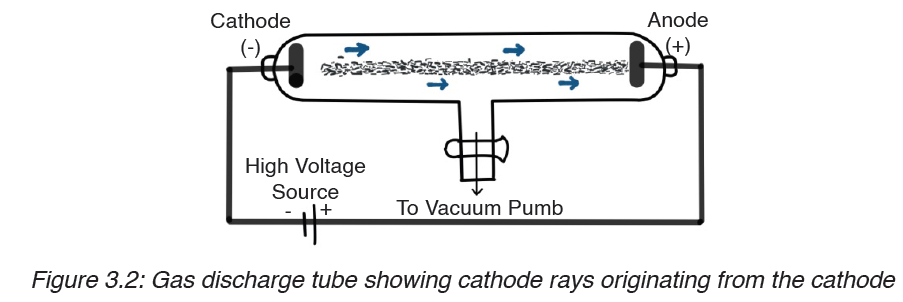
The gas discharge tube is an evacuated glass tube and has two electrodes, a cathode (negative electrode) and an anode (positive electrode). The electrodes are connected to a high voltage source. Inside the tube, an electric discharge occurs between the electrodes.
The discharge or ‘rays’ originate from the cathode and move toward the
anode, and hence are called cathode rays. Using luminescent techniques,
the cathode rays are made visible and it was found that these rays are
deflected away from negatively charged plates. The scientist J. J. Thomson
concluded that the cathode rays consist of negatively charged particles, and
he called them electrons.
Thomson postulated that an atom consisted of a diffuse cloud of positive
charge with the negative electrons embedded randomly in it. This model,
shown in Figure 3.3, is often called the plum pudding model because the
electrons are like raisins dispersed in a pudding (the positive charge cloud), as in plum pudding.

In 1909 Robert Millikan (1868–1953) conducted the famous charged oil
drop experiment and came to several conclusions: He found the magnitude
of the charge of an electron equal to −1.602×10−19C .From the charge-tomass
ratio(e/m) determined by Thomson, the mass of an electron was also
calculated.

3. Discovery of Protons and Rutherford’s Atomic Model
In 1886 Eugene Goldstein (1850–1930) observed that a cathode-ray tube
also generates a stream of positively charged particles that move towards
the cathode. These were called canal rays because they were observed
occasionally to pass through a channel, or “canal,” drilled in the negative
electrode (Figure 3.4). These positive rays, or positive ions, are created
when the gaseous atoms in the tube lose electrons. Positive ions are formed by the process
Atom→ cation + e- (energy absorbed)
Different elements give positive ions with different e/m ratios. The regularity
of the e/m values for different ions led to the idea that there is a subatomic
particle with one unit of positive charge, called the proton. The proton is a
fundamental particle with a charge equal in magnitude but opposite in sign to
the charge on the electron. Its mass is almost 1836 times that of the electron.
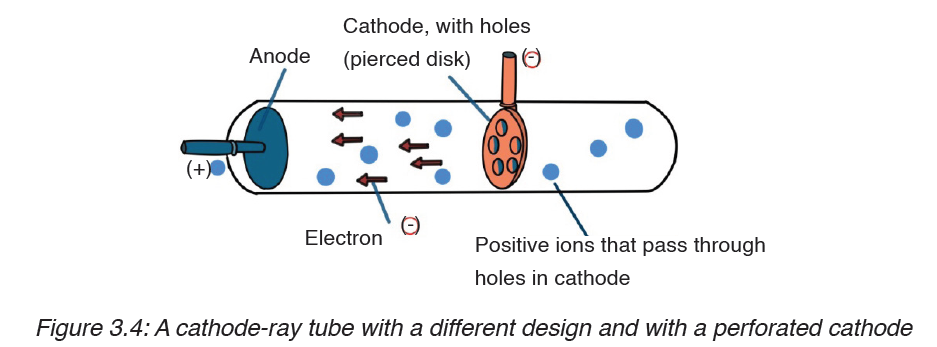
The proton was observed by Ernest Rutherford and James Chadwick in 1919 as a particle that is emitted by bombardment of certain atoms with α-particles.
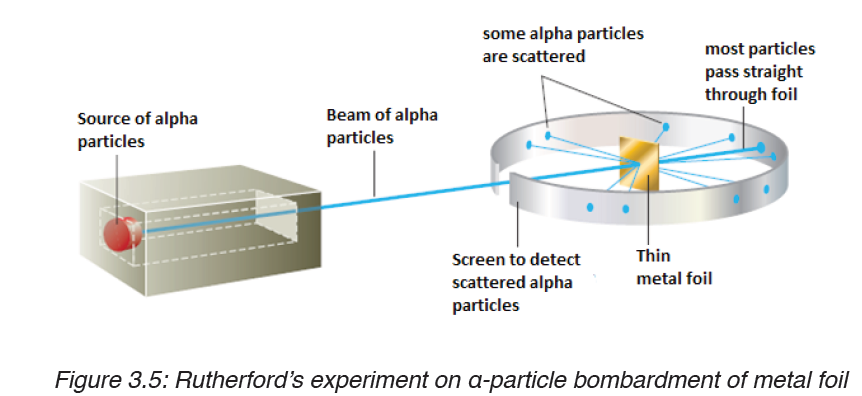
Rutherford reasoned that if Thomson’s model were accurate, the massive
α-particles should crash through the thin foil like cannonballs through gauze,
as shown in Figure 3.6(a). He expected α-particles to travel through the foil
with, at the most, very minor deflections in their paths. The results of the
experiment were very different from those Rutherford anticipated. Although
most of the α- particles passed straight through, many of the particles were
deflected at large angles, as shown in Figure 3.6(b), and some were reflected,
never hitting the detector. This outcome was a great surprise to Rutherford.
Rutherford knew from these results that the plum pudding model for the
atom could not be correct. The large deflections of the α-particles could be
caused only by a centre of concentrated positive charge that contains most
of the atom’s mass, as illustrated in Figure 3.6(b). Most of the α-particles
pass directly through the foil because the atom is mostly empty space. The
deflected α-particles are those that had a “close encounter” with the massive
positive centre of the atom, and the few reflected α-particles are those that
made a “direct hit” on the much more massive positive centre.
In Rutherford’s mind these results could be explained only in terms of a
nuclear atom—an atom with a dense centre of positive charge (the nucleus)
with electrons moving around the nucleus at a distance that is large relative
to the nuclear radius.

4. Discovery of Neutrons
In spite of the success of Rutherford and his co-workers in explaining atomic
structure, one major problem remained unsolved.
If the hydrogen contains one proton and the helium atom contains two
protons, the relative atomic mass of helium should be twice that of hydrogen.
However, the relative atomic mass of helium is four and not two.
This question was answered by the discovery of James Chadwick, English
physicist who showed the origin of the extra mass of helium by bombarding
a beryllium foil with alpha particles.
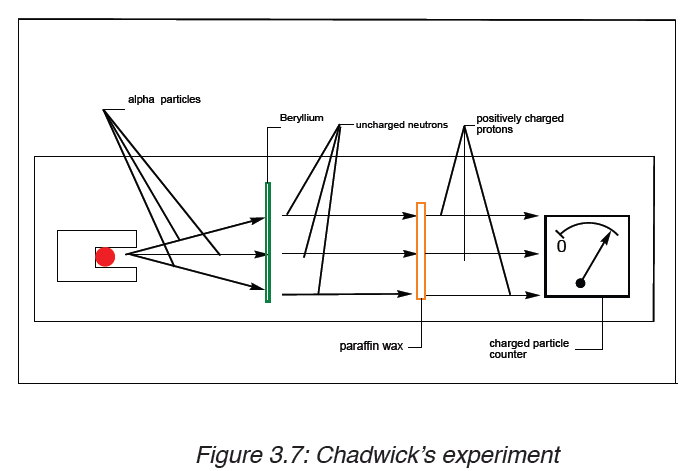
I n the presence of beryllium, the alpha particles are not detected; but they
displace uncharged particles from the nuclei of beryllium atoms. These
uncharged particles cannot be detected by a charged counter of particles.
However, those uncharged particles can displace positively charged
particles from another substance. They were called neutrons. The mass of
the neutron is slightly greater than that of proton.
Figure 3.8 shows the location of the elementary particles (protons, neutrons,
and electrons) in an atom. There are other subatomic particles, but the
electron, the proton, and the neutron are the three fundamental components
of the atom that are important in chemistry.

As a result of the experiments described above, it is found that atoms consist
of very small, very dense nuclei surrounded by clouds of electrons at
relatively great distances from the nuclei. All nuclei contain protons; nuclei
of all atoms except the common form of hydrogen also contain neutrons.
5. Properties of sub-atomic particles
Protons and neutrons are collectively known as nucleons. Both protons and
neutrons have a mass almost equal to that of hydrogen atom. The neutron
has no charge whereas the proton carries one positive charge. The electron
with one negative charge occupies the space outside the nucleus.
The following table summarizes the relative masses, the relative charges
and the position within the atom of these sub-atomic particles.
Table 3.1: Subatomic particles and some of their properties

(*amu: atomic mass unity, 1 amu=1.67×10-27kg)
Application activity 3.1
1. In an experiment, it was found that the total charge on an oil drop
was 5.93 × 10-18 C. How many negative charges does the drop contain?
2. All atoms of the elements contain three fundamental particles.
True or false? Give an example to support your answer.
3. Compare the atom constituents
a) in terms of their relative masses
b) in terms of their relative charges
4. Explain why:
a) J.J Thomson concluded that all atoms have the same negatively charged particles.
b) Most alpha particles pass straight through tin metal foil.
c) Some alpha particles are scattered.
3.2 Concept of atomic number, mass number, isotopic mass and relative atomic mass
Activity 3.2
The diagram below shows a representation of sodium isotopes ( AZNa ).
Observe it and answer to the questions that follow.

1. Find the values of A and Z for isotope 1 and isotope 2.
2. From your observation, how do you define the isotopes of an element?
3. How is A, the mass number, determined?
4. What information is provided by the atomic number, Z?
5. What is the relationship between the number of protons and the number of electrons in an atom?
6. Where are the electrons, protons, and neutrons located in an atom?
7. The mass of an atom is concentrated in the centre. Try to find an explication to this.
8. Say which one(s) of the following statements is(are) correct and
which one(s) is(are) wrong: (i) isotopes differ in their number of
electrons, (ii) isotopes differ in their mass numbers, (iii) isotopes
differ in their number of protons, (iv) isotopes differ by their number
of neutrons, (v) all the statements are wrong.
– The atomic number or proton number, Z, denotes the number of
protons in an atom’s nucleus. It corresponds to the order of the element in the periodic table.
– The mass number or nucleon number, A, denotes the total number of protons and neutrons in an atom.
Mass number = number of protons + number of neutrons
= atomic number + neutron number
– The number of neutrons can be obtained by subtracting the atomic number from the mass number.
– Chemists use the following shorthand to represent an atom. The mass number is shown as a superscript (top number) and the atomic number is shown as a subscript (bottom number) beside the symbol of the element.
By convention, the atomic number is usually written to the left subscript of the elemental notation, and the mass number to the left superscript of the elemental notation as represented by the example below, where X represents any elemental symbol.
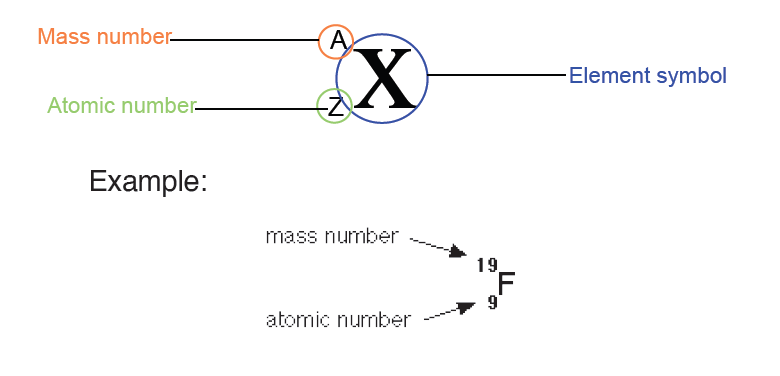
Some atoms of the same element have the same atomic number and different
mass numbers. This means a different number of neutrons. Such atoms are
called isotopes of the element. They are nuclides of the same element.
Example:

Isotopes of an element have the same chemical properties because they
have the same number of electrons.
– When elements react, it is the electrons that are involved in the reactions:
this means that the isotopes of an element cannot be differentiated by chemical reactions.
– Because isotopes of an element have different numbers of neutrons,
they have different masses, and isotopes have slightly different physical properties.
– The mass of a single isotope is its isotopic mass. The relative isotopic
mass of an isotope is the relative mass of that isotope compared with
the isotope which is given a mass of 12.00 units (12.00 atomic mass
units). That is, relative isotopic mass relates to the relative atomic mass
scale on which one isotope of the carbon element, carbon-12, is taken
as the reference standard for atomic masses and is given a relative
mass of 12 units, precisely 12 atomic mass units (a.m.u).

– Atomic mass unit (a.m.u) is a unit of mass used to express “relative
atomic masses”. It is 1/12 of the mass of the isotope of carbon-12 and is equal to 1.66054x10-27kg.
– The relative isotopic masses of all other atoms are obtained by comparison with the mass of a carbon-12 atom.
– On that scale, the relative atomic mass of a proton and that of a neutron are both very close to one unit (1.0074 and 1.0089 units respectively).
Since the relative mass of an electron is negligible (0.0005units), it follows that all isotopic masses will be close to whole numbers.
– However relative atomic masses of elements are not close to whole numbers because natural occurring elements are often mixtures of isotopes.
Application activity 3.2
1. How do you call the members of each of the following pairs?
Explain.
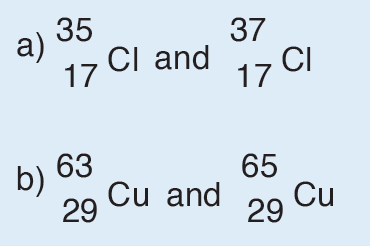
2. Write, using the periodic table, the correct symbols to identify an atom that contains
a) 4 protons, 4 electrons, and 5 neutrons;
b) 23 protons, 23 electrons, and 28 neutrons;
c) 54 protons, 54 electrons, and 70 neutrons; and
d) 31 protons, 31 electrons, and 38 neutrons.
3. Use the list of the words given below to fill in the blank spaces.
Each word will be used once.
Atomic number, Mass number, Protons, Electrons, Isotopes,
Neutron
a) The atomic number tells you how many __________________ and
____________________ are in an atom.
b) ____________________ is the number written as subscript on the
left of the atomic symbol.
c) The total number of protons and neutrons in an atom is called the
_____________________________________.
d) Atoms with the same number of protons but different number of
neutrons are called _____________________________.
e) The subatomic particle that has no charge is called a
________________________.
3.3 Calculations of the relative atomic masses of elements
Activity 3.3
Using textbooks and internet connection, explain the concept of relative
mass and attempt to solve the problems below.
1. Argon has three naturally occurring isotopes: argon-36, argon-38
and argon-40. The reported relative atomic mass of Argon (Ar)
from the periodic table is 39.948, which isotope do you think is the
most abundant in nature? Explain.
2. Calculate the average atomic mass of an element with two naturally
occurring isotopes: 85X (72.15%, 84.9118 amu) and 87X (27.85%,
86.9092 amu). Identify this element.
3. Boron has two naturally occurring isotopes. Find the percent
abundances of 10B and 11B given the isotopic mass of 10B = 10.0129
amu and the isotopic mass of 11B = 11.0093 amu.
Relative atomic mass, symbolized as R.A.M (Ar), is defined as the average
of the relative isotopic masses of the different isotopes weighted in the
proportions in which they naturally occur.
Thus, the different isotopic masses of the same elements and the percentage
abundance of each isotope of an element must be known in order to
accurately calculate the relative atomic mass of an element.
Notice: Remember that mass number is not the same as the relative atomic
mass or isotopic mass! The mass number is the total number of protons and
neutrons while relative atomic mass is the average of the isotopic masses.
Let A1, A2, A3,…, An be an abundance of n isotopes of the same chemical
element with atomic mass M1, M2, M3,…, Mn respectively, the relative atomic
mass (R.A.M) is given by the following equation:

Example 1
Oxygen contains three isotopes 16O, 17O, and 18O. Their respective relative
abundances are 99.76%, 0.04%, and 0.20%. Calculate the relative atomic
mass of oxygen.
Solution:
Relative isotopic mass of 16O is 16 and its relative abundance is 99.76%;
Relative is otopic mass of 17O is 17, abundance 0.04%;
Relative isotopic mass of 18O is 18, abundance 0.20%.

By applying the same formula, the relative abundance of the isotopes may be
calculated knowing the relative atomic mass of the element and the atomic
masses of the respective isotopes.
Example 2
Chlorine contains two isotopes 35Cl and 37Cl, what is the relative abundance
of each isotope in a sample of chlorine if its relative atomic mass is 35.5?
Solution:

Note that if the abundance of the isotope of atomic mass 35 is A%, the
abundance of the isotope of mass 37 will be (100 – A) %.
0.35A + (100 – A) x 0.37 = 35.5
0.35A– 0.37A =35.5 – 37
– 0.02A = – 1.5
A= 1.5/0.02 = 75
Therefore, the abundance of the isotope of relative atomic mass 35.5 is 75%
while that for the isotope 17Cl is 100 – 75 = 25%.
Application activity 3.3
1. Three isotopes of magnesium occur in nature. Their abundances
and masses are listed in the following table. Use this information
to calculate the relative atomic mass of magnesium.

2. The atomic weight of gallium is 69.72 amu. The masses of the naturally occurring isotopes are 68.9257 amu for 69Ga and 70.9249 amu for 71Ga. Calculate the percent abundance of each isotope.
SKILLS LAB 3
Using adequate materials construct any three models of atoms of your
choice. These models show shells and all electrons. These atoms should
be any three of this list: Cl, C, H, O, N, B, F.
End unit assessment 3
I. Multiple choice questions
1. Which of the following is true regarding a typical atom?
a) Neutrons and electrons have the same mass.
b) The mass of neutrons is much less than that of electrons.
c) Neutrons and protons together make the nucleus electrically neutral.
d) Protons are more massive than electrons
2. Which of the following statements is(are) true? For the false statements, correct them.
a) All particles in the nucleus of an atom are charged.
b) The atom is best described as a uniform sphere of matter in which electrons are embedded.
c) The mass of the nucleus is only a very small fraction of the mass of the entire atom.
d) The volume of the nucleus is only a very small fraction of the total volume of the atom.
e) The number of neutrons in a neutral atom must equal the number of electrons.
3. Each of the following statements is true, but Dalton might have
had trouble explaining some of them with his atomic theory. Give explanations for the following statements.
a) Atoms can be broken down into smaller particles.
b) One sample of lithium hydride is 87.4% lithium by mass, while another sample of lithium hydride is 74.9% lithium by mass.
However, the two samples have the same chemical properties.
II. Short and long answer questions
1. What are the three fundamental particles from which atoms are
built? What are their electric charges? Which of these particles
constitute the nucleus of an atom? Which is the least massive
particle of the fundamental particles?
2. Verify that the atomic weight of lithium is 6.94, given the following information:
6Li, mass = 6.015121 u; percent abundance = 7.50%
7Li, mass = 7.016003 u; percent abundance = 92.50%
3. Lithium has 2 naturally occurring isotopes. Lithium-6 has an atomic
mass of 6.015 amu ; lithium-7 has an atomic mass of 7.016 amu.
The atomic mass of lithium 6.941 amu. What is the percentage of
naturally occurring Li-7 ?
4. Observe the table below and complete by the missing data.
